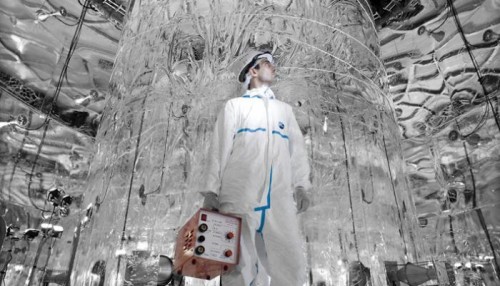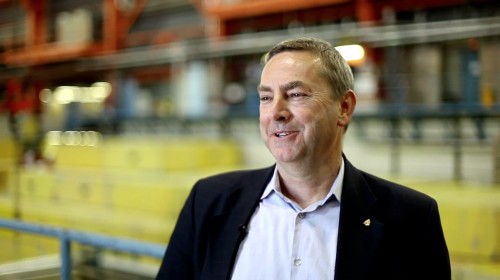Tag archives: particle physics
T2K discovery puts neutrino oscillation beyond doubt

The SuperKamiokande detector lies 1 km underground in the Mozumi mine in the city of Hida. (Courtesy: Kamioka Observatory, Institute for Cosmic Ray Research, University of Tokyo)
By Hamish Johnston
Physicists working on the Tokai to Kamiokande (T2K) experiment have confirmed what many have suspected for nearly three decades – over time, a neutrino of one flavour will change into a neutrino of another flavour in a process called neutrino oscillation.
View all posts by this author | View this author's profile
GERDA puts new limit on neutrinoless double beta decay

The GERDA experiment at Gran Sasso. (Courtesy: INFN)
By Hamish Johnston
This stylish chap is looking for an incredibly rare nuclear process called neutrinoless double beta decay. The picture was taken deep under a mountain at Italy’s Gran Sasso National Laboratory, which is about 160 km north-west of Rome. He is standing in a cavern containing the GERDA experiment, which has been searching for the rare decay since 2011.
GERDA hasn’t actually detected a decay event, but the collaboration claims to have measured the best value yet of the lower limit on its half-life in germanium-76. They researchers say that it’s about 2.1 × 1025 years – or 21 yottayears!
View all posts by this author | View this author's profile
Explaining CERN, the Higgs and the LHC
By Matin Durrani
How well would you do if someone asked you to explain the Higgs boson or the Large Hadron Collider (LHC) at CERN?
If you’re a physicist, you’ll probably find it hard enough. But if you’ve never done any physics in your life, things must surely be trickier still, more so if a film crew from Physics World has shoved a camera up your nose.
These two short videos show the results of a straw poll of randomly selected visitors at last summer’s Bristol International Balloon Fiesta when we asked them to describe the Higgs boson and the LHC.
The reason we were at the fiesta is that we were making a separate film about a project by Bristol University physicist Dave Cussans where school students were measuring cosmic rays during a hot-air balloon flight – it being the centenary of Victor Hess’s discovery of these rays in a balloon flight in central Europe.
View all posts by this author | View this author's profile
Nigel Lockyer to take the reins at Fermilab

TRIUMF’s Nigel Lockyer will soon be Chicago bound. (Courtesy: TRIUMF)
By Hamish Johnston
The particle physicist Nigel Lockyer will take over as director of Fermilab in September this year. Lockyer is currently in charge of TRIUMF in Vancouver, Canada. He will succeed Pier Oddone, who is stepping down after heading Fermilab for eight years.
View all posts by this author | View this author's profile
The race to find the electric dipole moment

Congress HQ: the University of Montreal actually has an ivory tower!
By Hamish Johnston at the 2013 CAP Congress in Montreal
Yesterday I had lunch with Jeff Martin of the University of Winnipeg, who is a member of an international team that aims to measure the electric dipole moment (EDM) of the neutron at TRIUMF in Vancouver.
BBC radio celebrates 101 years of cosmic rays
By Hamish Johnston

AMS is a modern version version of Hess’s balloon experiments. (Courtesy: NASA)
The BBC’s Melvyn Bragg has lots to talk about. Over the past few months he has chatted about the Icelandic sagas, water, Gnosticism, and much more on his Radio 4 programme In Our Time. So he can be forgiven for missing a centenary and celebrating cosmic rays 101 years after they were discovered by the Austrian physicist Victor Hess.
View all posts by this author | View this author's profile
Cash sought to finish Salam film
By Matin Durrani
I have always felt a bit uncomfortable about the “heroic” view of science – the idea that the most significant progress depends on the work of individual geniuses. Unfortunately, this is the way in which many people view scientific history, with the contributions of lesser mortals dismissed and swept aside.
However, it is fair to say that some physicists do stand head and shoulders above all others – none more so than Abdus Salam, who was (and still is) Pakistan’s only Nobel prize-winner.
Now two Pakistani film producers, Omar Vandal and Zakir Thaver, are creating a feature-length documentary about Salam’s scientific contributions – but they need your help to finish the job.
View all posts by this author | View this author's profile
What’s new with the ILC?
By Tushna Commissariat
Are you suffering from particle-collider withdrawal symptoms now that the LHC has begun its long shutdown? If so, you will be pleased to learn that you can focus your attention elsewhere.
The International Linear Collider Collaboration has posted an updated version of its 2013 Technical Design Report on the arXiv preprint server. It’s a short and sweet overview of the collider’s design, including “detailed descriptions of the accelerator baseline design for a 500 GeV e+e llinear collider, the R&D program that has demonstrated its feasibility, the physics goals and expected sensitivities, and the description of the ILD and SiD detectors and their capabilities”.
View all posts by this author | View this author's profile
What do you most hope the LHC will discover after it is switched back on in 2015?
By James Dacey

Admiring the insides of the CMS detector at CERN.
My colleague, Hamish Johnston, has just returned from a trip to CERN, where he was granted access to the insides of the Large Hadron Colider (LHC), which is currently being upgraded. He has shared some great photos from his trip on the Physics World Facebook page, including some snaps of the interior of the detector experiments.
First light at the NOvA neutrino detector

Burst of particles created when a muon interacts with the NOvA Far Detector. (Courtesy: NOvA collaboration)
By Hamish Johnston
Deep in the North Woods in Minnesota the snow is starting to melt, and the giant NOvA Far Detector is coming to life. Designed to register the arrival of neutrinos that will be created 810 km away at Fermilab near Chicago, the detector has recorded its first 3D images. These are not of neutrinos, but of the trajectories of fast-moving particles that are created in a process that begins with a cosmic ray colliding with Earth’s atmosphere.
View all posts by this author | View this author's profile